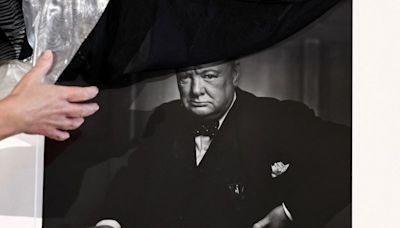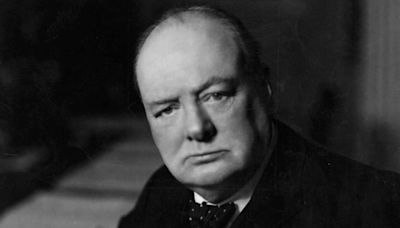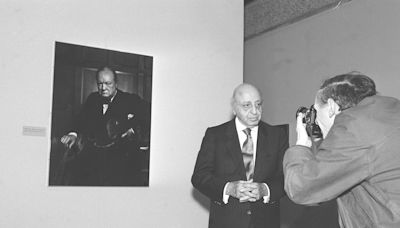Search results
A realistic and unflattering painting of the British prime minister, commissioned in 1954 and destroyed by his wife in 1978. Learn about the background, reception and fate of this controversial work of modern art.
- 30 November 1954
- How Did We Get Here?
- Sitting For Sutherland
- “Mortal Affront”
- “Something I Never Expected to See”
- The Fate of The Sutherland
- Culpability?
- The Author
- Endnotes and Further Reading
- GeneratedCaptionsTabForHeroSec
The scene is familiar to students of Churchill’s life. It is his eightieth birthday. In London, both Houses of Parliament have assembled in Westminster Hall to celebrate the occasion. They present him with the gift of a portrait, paid for by parliamentary subscription. They intend it to remain with him for his lifetime, and then to hang in the Pala...
In June 1954 the cumbersomely named “Churchill Joint Houses of Parliament Gift Committee” decided on the presentation of a portrait and who should receive the commission. Their first choice of Sir Herbert Gunn was rejected because he was too expensive. Gunn’s portrait of King George VIsuggests a work by him would have been more conventional, and fl...
Things started off hopefully enough. On 1 September Clementine Churchill wrote her daughter Mary: “Mr. Graham Sutherland is a ‘Wow’… [One] can hardly believe that the savage cruel designs which he exhibits come from his brush. Papa has given him three sittings & no one has seen the beginnings of the portrait except Papa & he is much struck by the p...
Churchill’s doctor Lord Moran worried that Sutherland would give up and “paint the legend.” Sir Winston, Moran said, “is always acting. Try to see him when he has got the greasepaint off his face.”3Sutherland felt he had solved the problem after he was able to observe and sketch Churchill playing a combative game of bezique, his guard temporarily d...
Sutherland had an explanation. In 1961 he would tell Lord Beaverbrook: “For better or worse, I am the kind of painter who is governed entirely by what he sees. I am at the mercy of my sitter. What he feels, or shows at the time, I try to record.”7 And 1954 was a bad time to have Churchill as a sitter. Four years later David McFall, working on Sir W...
The public never saw the portrait again. That is not to say that there was no demand for it. On 4 May 1960 the bursar of Churchill College wrote asking for various items they might display, including the Sutherland. There came a prompt and chilly response from Anthony Montague Browne, Churchill’s private secretary. “The suggestion about Graham Suth...
It is unrealistic to hold Sutherland culpable for Churchill’s disappointment. He delivered his commission. A painter, not a photographer, he worked within his brief and certainly within his style. Everyone knew Sutherland’s work at the time. It should have been clear, especially given his 1951 portrayal of Lord Beaverbrook, that he was no purveyor ...
Mr. Turrell has recently retired from a lifetime career in Information Technology. A longtime Churchill bibliophile and collector, he was formerly associate editor of Finest Hour.
1 Robert Rhodes James, ed., Winston S. Churchill, His Complete Speeches, 1897-1963, 8 vols. (New York: Bowker, 1974), VIII, 8608. 2 Mary Soames, Clementine Churchill: The Biography of a Marriage (Boston: Houghton Mifflin, 1970, 587. 3 Roger Berthoud, Graham Sutherland: A Biography (London: Faber & Faber, 1982), 189. 4 Jonathan Black, Winston Church...
How did the artist Graham Sutherland capture Churchill's expression and hands in his 1954 portrait commissioned by Parliament? Why did Churchill hate it and how did Sutherland defend his work?
The Roaring Lion is a famous photograph of Winston Churchill by Yousuf Karsh in 1941. Learn about the history, impact and theft of this iconic portrait of the British prime minister.
- Photograph
A close-up study of Churchill's head by the painter Graham Sutherland, commissioned to mark his eightieth birthday in 1954. The portrait was one of several studies for a controversial final painting that Churchill disliked and his wife destroyed.
Browse 228 portraits of Winston Churchill, the 20th century British Prime Minister and war leader. See his images by various artists, from albumen prints to bronze busts, and learn more about his life and legacy.
This haunting portrait of Winston Churchill, who would become one of Britain’s best-known prime ministers, captures him at a critical moment in his career. It was painted over eleven sittings in 1916 during the Dardanelles Commission, the official investigation into one of the most disastrous naval campaigns of the Great War.



